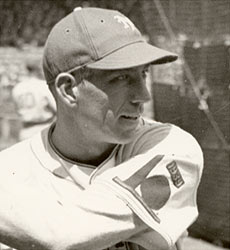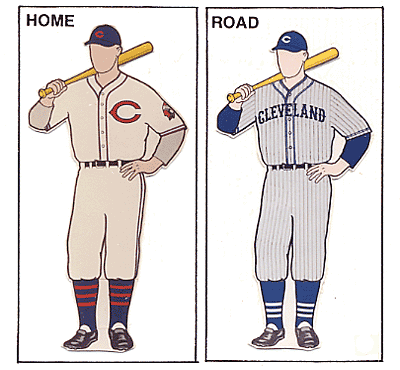On June 10, 1989, the United States Postal Service issued a stamp honoring Lou Gehrig created by artist Bart Forbes.

According to an article in the Chicago Sun-Times of April 16, 1989:
The design of the stamp showing the profile of Gehrig in Yankee pinstripes was taken from a picture owned by Mike Aronstein of New York. The foreground figure of the left-handed slugger is from a 1939 photograph by Herman Seid.
Here's the photo upon which the "foreground figure" was based:

Collection of the National Baseball Library
The photo can also be found at the Getty Images web site. Here is their watermarked version:

Getty Images preview image #82985728
The caption supplied by Getty Images reads as follows:
CHICAGO - 1938. Lou Gehrig whacks a double into left center in a game at Yankee Stadium in 1938. Luke Sewell is the catcher for the opponent White Sox.So, the Chicago Sun-Times and Getty Images disagree on the year of the image. And the Getty Images caption disagrees with itself, first stating the image is from "CHICAGO," then citing the location of the game as Yankee Stadium. What are we to believe?
First, take a close look at Gehrig's uniform:

Since Gehrig is wearing a jersey with the words "NEW YORK" across the chest (sans pinstripes), this is clearly a road uniform. So the photo is not taken at Yankee Stadium.
Also, a patch can be seen on the left sleeve of Gehrig's jersey. This was a special patch worn by all three New York-based big league clubs (the Yankees, Giants and Dodgers) in 1938 to promote the following year's 1939 World's Fair. Here's a better look at the patch as worn by Lou Chiozza of the Giants:

National Baseball Hall of Fame and Museum online exhibit Dressed to the Nines
Having established that the photo was taken in 1938 with the Yankees on the road, what is to be made of the Getty Images claim that the opposing club was the Chicago White Sox? Take a close look at the catcher's stockings:

According to the Dressed to the Nines uniform database, the White Sox of 1938 lived up to their name and wore all-white stockings. In fact, the only major league club whose 1938 home uniforms featured dark-colored stockings with stripes as seen in this photo was the Cleveland Indians. Here's what their uniform looked like in 1938:

Since the catcher is with the Indians with the Yankees on the road, the game must have been played in Cleveland. Thus, it appears that other than the identification of the batter (Gehrig) and the year (1938), the Getty Images caption is completely erroneous.
So, what can we determine about the photo?
According to the Indians' schedule of 1938, the Yankees visited Cleveland on four separate occasions:
- May 22 and 24
- June 21, 22 (doubleheader) and 23
- August 5, 6 and 7
- September 13
One of these dates must be the date of the photograph. But which? One clue that may help is the fact that from 1932 through 1946, the Indians played their home games at two different parks: League Park (also known as Dunn Field) and Cleveland Stadium (also known as Cleveland Municipal Stadium). By determining which park is pictured in our photo, we can narrow down the possible dates that it was taken.
Here's a well-known photograph of Joe DiMaggio hitting in his 56th straight game on July 16, 1941. The game took place at Cleveland's League Park. (His record streak ended the next night, but that game was played at Cleveland Stadium.)

Now compare the DiMaggio image to that of Gehrig:

Note the tarp rolled up in the background behind DiMaggio, as well as the gate in the low wall, just to the right of the left knee of Indians catcher Gene Desautels. Though the photo of DiMaggio photo was taken three seasons after the picture of Gehrig, it is clear that they were taken at the same location: League Park.
Of the ten games played between the Yankees and Indians in Cleveland in 1938, just four took place at League Park. These were the games of May 24, June 21, June 23 and September 13. According to box scores of these games, the following individuals umpired home plate and caught for the Indians:
- May 24: Home plate umpire Harry Geisel and catcher Frankie Pytlak.
- June 21: Home plate umpire Harry Geisel and catcher Rollie Hemsley.
- June 23: Home plate umpire Harry Geisel and catcher Frankie Pytlak.
- September 13: Home plate umpire Joe Rue and catcher Frankie Pytlak.
Here's a close-up of the catcher from the Gehrig photograph:

Now compare this individual's face with that of Frankie Pytlak:

Baseball in Wartime Blog
… and the other potential catcher, Rollie Hemsley:

The Conlon Collection
There's little question that the catcher is Frankie Pytlak, so we can eliminate June 21 from the possible dates.
Now for the umpire:

Is it Harry Geisel?

Or Joe Rue?

Again, it's not tough to identify the umpire as Geisel, so we are now left with two possible dates: Tuesday, May 24 and Thursday, June 23.
Searching newspapers that covered these games, I found the following photo as reproduced in the Cleveland Plain Dealer of June 25, 1938:

Of course the image is not identical, but at first glance it appears that the shot may have been taken just seconds after the photograph used in the stamp. However, despite the graininess of the halftone image, a close look reveals that neither Pytlak nor Gehrig are wearing the dark, long sleeves seen in the other photograph.
Why would the players dress differently for the two games? Take a look at the weather report for the two dates:
- May 24: 12:30 pm — 46 degrees and partly cloudy.
- June 23: 12:30 pm — 77 degrees and clear.
It would make sense that long-sleeved undergarments would be appropriate for the May 24th game, not the game of June 23rd. So, all signs point to May 24, though we still have not tracked down the exact same photograph used for the stamp.
As luck would have it, the photograph we're examining is in the photo collection of the National Baseball Hall of Fame and Museum, and was donated to the institution by a gentleman named Carl Seid. Carl was the son of Herman Seid, a longtime photographer for the Cleveland Press. Undoubtedly, the Gehrig photo was taken by Herman Seid. Indeed, a number of sources on the web credit the photograph to Seid, pictured below in 1954:

Cleveland Memory
Just two days before the Gehrig photograph was taken, in an Indians-Yankees game at Cleveland Stadium, the "Iron Horse" had rapped a long double to right-center field in the top of the sixth. As he headed into second, Gehrig felt a sharp pain in his back and thigh. He eventually managed to score, but Babe Dahlgren replaced him in the bottom of the inning. Rain canceled the game of May 23, but Gehrig came back to start on May 24, playing the entire game and going 1-for-3 with a double and two runs scored in a 9-5 loss to the Indians. Just one week later, back at Yankee Stadium, Gehrig played in his 2,000th straight game.
So, the stamp was based on a photograph of Gehrig taken by Cleveland Press photographer Herman Seid 75 years ago, May 24, 1938, at League Park, as the Indians hosted the Yankees.